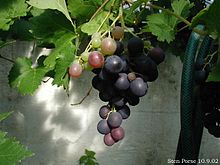Grapeseed flour
Grape seed flour (also called grape seed powder ) is a dark brown flour that is obtained from the seeds (kernels) of grapes .
Manufacturing
For the production of grape seed flour, the grape seeds are extracted from the press residue, the pomace , after the pressing process for wine production . A “destemming machine” (rotary sieve) separates the stones from the berry skin. The loose kernels are then dried with warm air and cleaned with an air sifter or an old grain winch so that the pure kernels remain. Then the kernels are dried again. The dried seeds are then cold-pressed in order to obtain grape seed oil from them . After pressing, the press cake remains , which is crushed by a screw conveyor , processed into granulate by a rolling mill and finally ground very finely into grape seed flour in a grain or vortex mill. The heat development is 40 to 50 ° C, and this temperature is only reached for a few seconds. Thanks to this gentle manufacturing process, the nutritionally valuable ingredients of grape seed flour can be preserved.
By extraction with water or ethanol , but also with chloroform u. a., grape seed extract can also be made from grape seeds . Here the content of oligomeric proanthocyanidins (OPC) is then greatly increased.
properties
The special thing about the nutty grape seed flour is the high occurrence of OPC , a secondary plant substance with an antioxidant effect. The antioxidant capacity of a food can be described with the ORAC value (Oxygen Radical Absorption Capacity). Thanks to its high OPC content, grape seed flour is one of the foods with the highest ORAC value: 100,000 μmol TE / 100g.
use
Use in food
The special thing about grape seed flour is that it retains its valuable ingredients when heated up strongly. For this reason it is very good for baking, but only proportionally (5 to 10%) to conventional flours. It gives all baked goods and dishes a hearty and hearty taste. Grape seed flour is also suitable for breading or flouring meat and fish. For example, a ready-made baking mix for grape seed bread, a flour mix with spelled flour and various pasta with grape seed flour are available on the food market .
Use as a dietary supplement
Grape seed flour can be used pure z. B. can be stirred into smoothies or juices (1 teaspoon per serving) or in the form of grape seed capsules. It can also be added to muesli or yogurt. However, it should not be taken together with dairy products, as the protein it contains reduces the antioxidant effect of the OPC.
Use in animal feed
Due to its valuable nutrients and active ingredients, grape seed flour is used in the animal feed sector and is processed by various manufacturers as a feed additive.
Nutritional values
Grape seed flour is gluten-free , lactose-free and contains over 50% dietary fiber .
| Average nutritional values per 100 g | |
|---|---|
| Calorific value | 1,129 kJ / 273 kcal |
| Water content | 6.1 g |
| Dry matter | 93.9 g |
| protein | 10.4 g |
| fat | 4.32 g |
| Carbohydrates (without fiber) | 20.0 g |
| sugar | 5.7 g |
| Fiber | 56.6 g |
| ash | 2.7 g |
| sodium | 1.71 mg |
| Vitamin E. | 0.95 mg |
Individual evidence
- ↑ traubenkernmehl.com: grape seed flour, grape seed oil and OPC
- ↑ orac-info-portal.de: ORAC value
- ↑ traubenkernmehl.com: grape seed flour, grape seed oil and OPC

